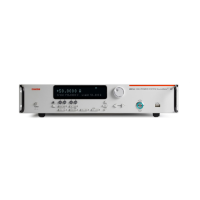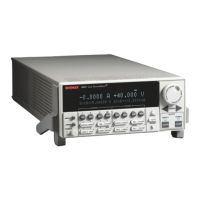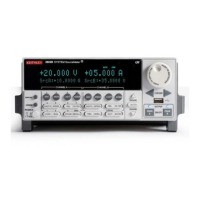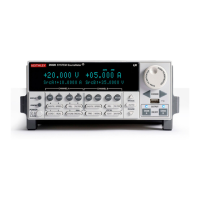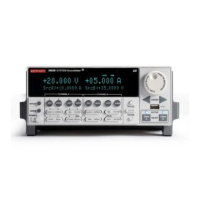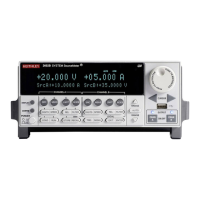Section 3: Functions and features Model 2657A High Power System SourceMeter® Instrument Reference Manual
3-52 2657A-901-01 Rev. B/December 2012
The command queue can fill up with trigger entries if too many *TRG messages are received while a
test script is running, even if the script is processing triggers. You can avoid this by using the
localnode.prompts4882 attribute (see TSP command reference (on page 7-1) for more
information), and by using trigger.wait() calls that remove the *TRG messages from the
command queue. If the command queue fills with too many trigger entries, messages like abort will
not be processed.
Manual triggering
The TRIG key is used for manual triggering. Each time the TRIG key is pressed, a trigger event is
generated. You can monitor for a manual trigger event using the event ID
display.trigger.EVENT_ID. See Using the TRIG key to trigger a sweep
(on page 3-38) for an
example of how to use a manual trigger.
There are no action overruns for manual triggering.
Interactive triggering
The complexity of some test system configurations may not allow a static trigger setup. These
configurations would require more dynamic control of triggering than the static trigger setup provides.
For such cases, a setup providing interactive trigger programming would allow the generation and
detection of trigger events that can be controlled on demand under remote control. For example,
interactive triggering can be used when you need to make multiple source function changes or
implement conditional branching to other test setups based on recent measurements.
Detecting trigger events using the wait() function
All of the Model 2657A trigger objects (except for SMUs) have built-in event detectors that monitor for
trigger events. The event detector only monitors events generated by that object and cannot be
configured to monitor events generated by any other trigger object. Using the wait() function of the
trigger object causes the Model 2657A instrument to suspend command execution until a trigger
event occurs or until the specified timeout period elapses.
For example, use trigger.blender[N].wait(Y) to suspend command execution until an event
blender generates an event, where N is the specific event blender and Y is the timeout period. After
executing the wait() function, the event detector of the trigger object is cleared.
The following programming example illustrates how to suspend command execution while waiting for
various events to occur:
-- Wait up to 10 seconds for a front-panel TRIG key press.
display.trigger.wait(10)
-- Wait up to 60 seconds for timer 1 to complete its delay.
trigger.timer[1].wait(60)
-- Wait up to 30 seconds for input trigger to digital I/O line 10.
digio.trigger[10].wait(30)
NOTE
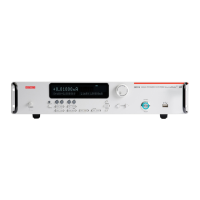
